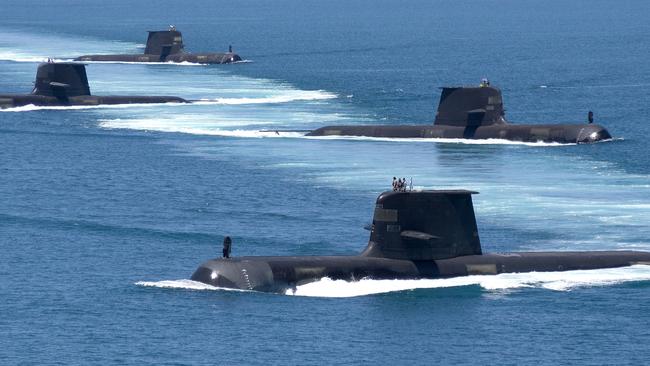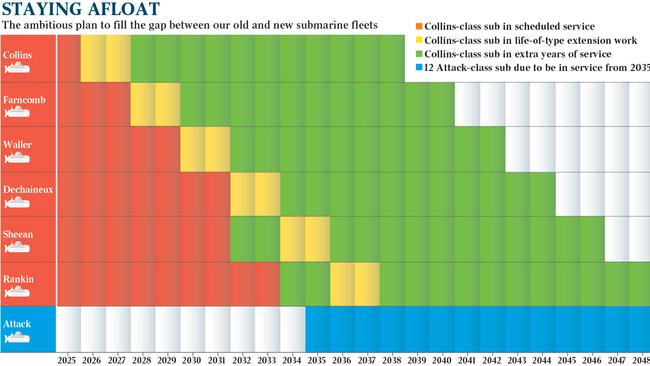Submarines refit plan ‘will leave us exposed’
The shipbuilder who led the construction of the navy’s Collins-class submarines has warned that the Morrison government’s new timeline for extending their life is too ambitious.

The shipbuilder who led the construction of the navy’s Collins-class submarines has warned that the Morrison government’s new timeline for extending their life is too ambitious and that Australia risks a major capability gap in its submarine fleet by the 2030s.
A new report by the country’s leading naval shipbuilders, delivered to the office of Defence Minister Peter Dutton, paints a dire picture of the likelihood of Australia maintaining a potent submarine deterrent while it awaits the arrival of the French Attack class boats from 2035.
Coming ahead of Scott Morrison’s meeting with French President Emmanuel Macron next week, the report is also highly critical of the slow progress of the $90bn plan to build 12 French Attack-class submarines in Adelaide, saying the cost is excessive and is “subject to significant risks and potential delays … at a time when Australia can least afford that outcome”.
The Australian this week revealed Mr Dutton has ordered all six Collins-class submarines to be completely rebuilt to extend their life for another decade to try to safeguard the nation’s submarine capability in the face of an increasingly aggressive China.
The plan is to conduct a complete rebuild, known as a life-of-type-extension, on each Collins boat over a two-year period once they progressively reach the end of their original 30-year life cycle, beginning in 2026.
Mr Dutton’s order for all six Collins-class boats to be rebuilt, compared with Defence’s initial plan to refit just three boats, aims to keep the submarines operational until the 2040s and minimise the risk of a gap in submarine capability from later this decade.
Defence has never conducted such a major refit of a submarine, which involves the complete gutting of the boat and the replacement and upgrading of all key systems, including diesel generators, main motors, batteries, sensors and digital periscopes.

The experts’ report, written by former senior public servant with PM&C Jon Stanford, the former Collins-class shipbuilder Hans Ohff, the builder of the navy’s Anzac frigates John White and former navy commodore Paul Greenfield, warns that it would be impossible to complete such a rebuild in just two years as planned.
“The work flagged for LOTE so far is very extensive, almost equivalent, according to our experts, to designing a new submarine,” the report states. “Hans Ohff (the head of Collins builder ASC from 1993 to 2002) has expressed the view that it would take at least four years to complete the work on the first submarines.
“If the LOTE takes significantly longer than two years, the availability of submarines for deployment would soon be reduced and a major capability gap will open up which will gradually grow over time.
“(This comes) when Australia’s strategic circumstances may be even more threatening and when the original intention was for 12 submarines to be available in that decade (the 2030s).”
The report recommends the government create competition for French submarine builder Naval Group by approving a preliminary design study with the Collins-class designer, Sweden’s Saab Kockums, for an Evolved Collins-class submarine.
It says that by also involving Saab Kockums heavily in the LOTE program, the government would have the option of eventually constructing a completely new submarine based on the Collins design if it chose to walk away from the French project.
“Ideally, after the second or third partial LOTE, there would come a time when Saab Kockums could begin to construct a new submarine evolved from the Collins with the benefit of having already tested many of the main new systems required for the new boats,” the report states.
“The first new submarine could be delivered within nine years, with the remainder following at a two year drumbeat at first, then reducing to one year.’
The Attack-class project has been troubled by delays and disagreements about the level of Australian industry content in the program. The project is currently at an impasse over the price of the contract for the detailed design of the submarines.




To join the conversation, please log in. Don't have an account? Register
Join the conversation, you are commenting as Logout